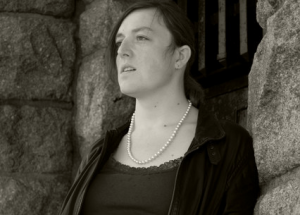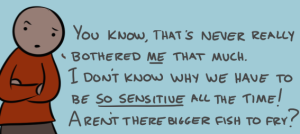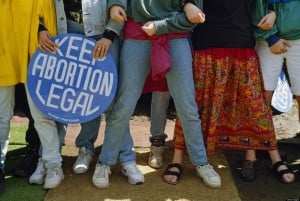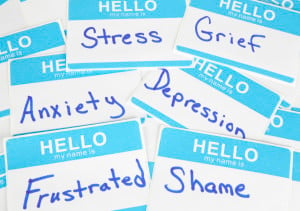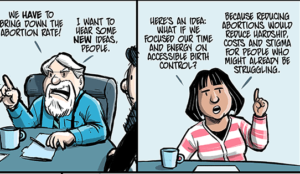I’m from the Bronx.
And believe me when I say I love my borough.
I’m proud to be from a place filled with deeply rooted heritage, culture, and history. This is the birthplace of so many activists, artists, and change-makers, and it makes my heart swell with pride every time I rep where I’m from.
But I don’t love the stilted silences, the awkward laughs, and the obnoxious questions that always, always follow me.
“Isn’t there, like, so much crime there? Have you ever seen someone get shot?”
“Why don’t your people care about where you live? Everything is so filthy and so old!”
“But you’re so well-spoken. How can you be from such a bad neighborhood?”
This annoys me because, like many forms of oppression, it seems like people can only understand things on an individual level.
Many don’t understand that places like the Bronx aren’t “bad” because of who lives there, but because of what has been done to us, what has been kept from us, and all the ways those choices continue to be institutionally validated and perpetuated.
Neighborhoods that are mainly Black and mainly low-income weren’t just born.
Black communities across the North – like in Chicago, Detroit, Philadelphia, Harlem, and yes, parts of the Bronx – were intentionally created by governments, landowners, and policymakers who wanted to systemically keep People of Color out of white neighborhoods.
Like so much of anti-Black policies that exist in the United States today, the creation of Black neighborhoods began with slavery.
Even though all Northern states had passed legislation that abolished slavery by 1804, abolition was not complete and immediate throughout the North. Pennsylvania passed the Act for the Gradual Abolition of Slavery in 1780; yet by 1850, hundreds of Black people were still enslaved.
Even with the complete abolition of slavery, Black people were not given the full benefits of citizenship or personhood in Northern states. Many Northern white abolitionists didn’t advocate for full integration or equity for Black people.
The legacy of slavery continued through segregationist, discriminatory laws that were seeped in anti-Blackness. Even European immigrants, such as the Irish or Italian, actively benefited from anti-Black racism.
Professor Margaret Washington has explained, “So it would seem as though the nation itself had an attitude that African Americans were inferior…. The whole idea of Jim Crow and segregation of the races really originates in the North.”
This isn’t to say that Black-only neighborhood have only grown out of segregationist laws. Many were actively created as safe spaces where communities could thrive and succeed.
However, it’s important to understand the history of how Black neighborhoods had to be created, because of systemic violence, segregationist laws, and discriminatory practices.
And the creations of these neighborhoods weren’t limited to the South. Northern anti-Blackness was just as prominent, if maybe more covert. These attitudes and policies also have continued well into the 21st century.
Starting in the 1900s, below are just a few ways that Black neighborhoods have been created and systemically marginalized.
1900s – 1950s
Post-Reconstruction, white supremacy was visibly rampant across the South.
Black people experienced widespread violence, from systemic lynchings to wide-scale massacres. Meanwhile, the North was experiencing an economic boom. Especially during World War I, there was a massive need for cheap industrial labor.
These are two critical reasons for the Great Migration, a massive movement of Black people migrating from the South to the North. The Black populations of Northern cities like New York, Chicago, Boston, and Detroit increased a hundredfold.
White lawmakers and landowners began creating discriminatory policies.
First, they ensured that Black people – even wealthy ones – couldn’t move into white neighborhoods. Second, they ensured that Black neighborhoods wouldn’t receive government funding or any kind of assistance, keeping them impoverished.
1. Restrictive Covenants
Essentially, restrictive covenants are agreements amongst folks in a neighborhood binding them to not sell, lease, or rent to people based on their race.
Restrictive covenants were used across cities in the North during the early 1900s in order to stop Black people from moving into white neighborhoods.
Formal deeds were drawn up in order to stop property owners from renting and selling to Black folks.
It wasn’t until 1948, with the Supreme Court ruling in Shelley v. Kraemer, that the use of restrictive covenants declined. Even though it didn’t outright outlaw restrictive covenants, the Court ruled that restrictive covenants cannot be reinforced by the state.
2. Redlining
The National Housing Act (NHA) was part of the New Deal in order to make buying and mortgaging houses more affordable.
The NHA was supposed to improve housing standards and mortgage/loan practices and help end “crime-ridden slums” and the Great Depression.
And this definitely worked out well – for white people, of course.
Because of the NHA, the Home Owners’ Loan Corporation created maps of over 200 cities, marking areas for real estate investments. They created a color-coded system in order to determine which neighborhoods would be viable for loans and mortgages.
Black neighborhoods were literally outlined in red and marked as “high-risk areas.”
This suggested that they shouldn’t be invested in because of increased rates of crime and poverty – which only occurred because of these spaces being historically disenfranchised.
This meant a number of things.
Banks began to deny mortgages to people already living in these neighborhoods because of the risk. Loan availability to move out of these neighborhoods became almost nonexistent. Many of the buildings in these neighborhoods fell into disrepair.
Without loans – or generational wealth – there was no money to buy or repair homes.
3. White Violence
When these legal means fell through, white people kept their neighborhoods segregated through physical violence and intimidation.
In “The Case for Reparations,” Ta-Nehisi Coates outlines housing segregation and violence against Black people in Chicago. The entire essay is a great overview, and he specifically speaks about the physical violence against Black people moving into white neighborhoods in order to keep them away.
Here, he speaks about specific Chicago neighborhoods where white people rioted and beat Black people who had moved into white neighborhoods:
In 1947, after a few black veterans moved into the Fernwood section of Chicago, three nights of rioting broke out; gangs of whites yanked blacks off streetcars and beat them…In 1951, thousands of whites in Cicero, twenty minutes or so west of downtown Chicago, attacked an apartment building that housed a single black family…
These acts of violence were not limited to Chicago. Across the country in suburbs of cities like Detroit, violence broke out, partially because of job and housing situations.
1950s – 1980s
Post-World War II and the New Deal, the economy was doing much better. People could actually afford to buy homes, and many in the North moved out of cities and into the suburbs.
Again, if you were white, you could do that. And thousands did, in a movement referred to as “White Flight.”
Although there is research that suggests the movement out of cities – and away from Black people – began as early as the Great Migration, it is mostly known as a post-WWII phenomenon.
Meanwhile, Black people were still forced to live in urban areas that had been actively disenfranchised and defunded.
White real estate investors, property owners, and land developers found new ways around anti-discrimination policies that were created.
Black people rich enough to leave cities faced violence and discrimination when trying to move into white neighborhoods.
4. Blockbusting
Blockbusting is the “practice of introducing African American homeowners into previously all white neighborhoods in order to spark rapid white flight and housing price decline.”
And this was a commonly used tactic well up into the 1980s.
What would happen is very simple.
White real estate agents and developers would stage Black people in a specific neighborhood.
In response, white people would rapidly sell their properties at extremely low prices because of how scared they were at the thought of Black people moving in. Then, the developers would sell these properties to Black people at double the cost.
These Black homeowners would then have an extremely hard time keeping their property for a number of reasons.
First, the rent was (literally) too damn high in the first place. Second, banks would refuse to give them homeowners’ loans to help with the burden. They would then have to buy a house “on contract.”
So, once a Black homeowner couldn’t keep up with the costs, these white developers would kick them out and do the same scheme with another Black family.
This created a perpetual cycle of poverty, where “displaced black homeowners [were forced] to move to already-crowded and segregated neighborhoods.”
Although blockbusting was outlawed with the Civil Rights Act of 1968, the damage had already been done.
5. Levittown
Levittown is not just one suburb, but seven different suburbs across the United States. All created by Levitt & Sons after WWII, they were housing developments made specifically for white people to escape overcrowding and Black people in the cities.
These Levittowns were privately owned, and so actively denied Black people the right to buy houses in them. Eugene Burnett, a Black man who tried to buy a house in a Levittown, explained how he was denied because of his race.
A salesman told him, “It’s not me, but the owners of this development have not as yet decided to sell these homes to Negroes.’”
Even after racial integration with Brown v. Board of Education, Levittowns remained segregated. In 2015, the same has held true. A Levittown in Long Island, New York, remains 94.15% white today.
Part of this is because Levittown, once very affordable for a middle-class Black family, is not any longer.
White people who lived in these suburbs were able to accumulate generational wealth in a way that Black people forced to live in cities could not.
6. The G.I. Bill
The G.I. Bill – or the Servicemen’s Readjustment Act of 1944 – was implemented in order to give back to WWII veterans.
In theory, the G.I. Bill was supposed to help those that served in almost every aspect of life. It created veteran’s hospitals, helped with college tuition, and even granted loans for new homebuyers.
However, Black veterans were still being denied housing in white suburbs.
So while white veterans could use their loans to buy homes and gain equity, Black veterans were not given the same opportunities.
Because they were not granted the loans – for housing or education – promised to them, not much changed in their lives. Many were forced to continue living in impoverished neighborhoods with no support.
7. Urban Renewal
The Housing Act of 1949 was initially created in order to create better housing opportunities for Americans.
A large part of the plan was to revitalize urban neighborhoods by tearing down old, dilapidated buildings and creating new developments, businesses, and highways.
Later, these kinds of projects were rebranded as “urban renewal.”
Federal funding went to these development projects in order to “clean up” the cities and make them better places to be in. The majority of these “urban renewal” projects happen in Black neighborhoods.
Developers, with the backing of federal funds, destroyed Black businesses and homes. And even though these families were promised that they would be relocated and compensated, many were not.
As James Baldwin famously stated, “[M]ost Northern cities are now engaged…in something called urban renewal, which means moving the Negroes out. It means Negro removal, that is what it means.”
This meant that Black families were displaced. Many were unable to afford to move into the white suburbs, and so had to move into already crowded, mainly Black, city apartments and public housing.
1980s – Present Day
After centuries of discriminatory housing policies, nothing much has changed today.
Although cities and the federal government have enacted anti-segregation laws and programs like Moving to Opportunity, which provided vouchers for poor Black people to move into the suburbs, both the government and private investors have continued to find ways to keep Black people in low-income, segregated areas.
And without generational wealth – often accumulated by owning property – it is extremely difficult to either move out of these neighborhoods or build them up for the community.
According to the Pew Research Center, white households have a median wealth that is twenty times higher than Black households. Even “well-off” Black folks do not have an improved standard of living.
Furthermore, with the rise of gentrification, our historical and cultural centers are being torn down.
As we’re being forced out of our created spaces – both because of legal discrimination and need – there are very few places for Black people to live in.
8. Predatory Lending
Predatory lending is a type of practice used by banks or other financial institutions.
Basically, it’s any practice that “imposes unfair or abusive loan terms on a borrower” or any practice that “ convinces a borrower to accept unfair terms through deceptive, coercive, exploitative or unscrupulous actions for a loan that a borrower doesn’t need, doesn’t want or can’t afford.”
Within the last few decades, big banks like Bank of America and Countrywide have exclusively used predatory loans on Latinx and Black people looking to buy homes.
They specifically created contracts where People of Color would pay tens of thousands of dollars more than white people with the same kind of credit.
One example takes place in Baltimore, focusing on the loan policies of Wells Fargo. Sociologists found that “Black borrowers paid an extra 5 to 11% in monthly payments that white borrowers did not have to pay.”
Predatory loans often lead to higher rates of foreclosure, thus making it impossible for Black families to keep their homes. Again, these families are forced to live with high amounts of debt and nowhere to live because of these banks.
9. Racial Steering
The American Planning Association defines racial steering as “the intentional behavior of real estate agents to direct clients to specific neighborhoods on the basis of race or ethnicity.”
This meant real estate investors could ensure that Black people would only buy in already Black neighborhoods by only showing them Black neighborhoods.
A 2006 report from the National Fair Housing Alliance showed that racial steering is overwhelmingly used by real estate agents that they tested; in over 87% of cases, racial steering was used.
White clients were discouraged from moving to interracial neighborhoods and predominately shown houses in majority-white neighborhoods. Furthermore, Black clients received “very limited service” in comparison to white ones.
This discriminatory treatment of Black would-be homebuyers is also highlighted in American Apartheid: Segregation and the Making of the Underclass.
Furthermore, real estate investors would also use coded language with white clients.
The same National Fair Housing Alliance report explained that talking about school districts was a way to steer clients towards or away from a neighborhood.
It states, “…many real estate agents told whites to avoid certain areas because of the schools. It is evident from the investigation that schools have become a proxy for the racial or ethnic composition of neighborhoods.”
10. Neighborhood Disinvestment
Neighborhood disinvestment is when landlords and governmental agencies do not provide proper services to communities. This includes things like refusing to fix building problems, little to no sanitation pick-ups, and lack of transportation.
This has primarily happened in Black neighborhoods, and has continued well into the present day.
Once neighborhoods have fallen into disrepair, developers can buy the land for fairly cheap prices. A cycle of urban renewal essentially happens. Housing can be torn down, displacing people, and filled with condos, businesses, and other luxury services.
Gentrification also plays a massive role in neighborhood disinvestment.
“Gentrification, Displacement, and the Role of Public Investment” explains “gentrification literature conceptualizes neighborhoods as terrain not of isolated pockets of decline and abandonment, but rather as sites of exploration, potential investment, and emergent identity construction.”
Basically, newcomers – mainly white, wealthier people – see these neighborhoods as places that can be “up and coming.”
Black neighborhoods are not valued as sites of culture, community, and resistance on their own. Rather, they become sites of colonization, making them unrecognizable and often unsafe for the people who have always been living there.
You might be saying to yourself, “Colonization? Come on. Gentrification doesn’t sound too bad. It creates integrated neighborhoods, right? That’s basically the opposite of racial steering.”
Which, yeah. If gentrification was just about neighborhood integration or cultural sharing, of course that would be great!
But it’s not.
On an individual and institutional level, what often happens is newcomers don’t assimilate to the people and culture of the space, but force their own visions onto these neighborhoods. They come in with their own biases about what and who is acceptable.
In gentrified neighborhoods, Black and brown people and our norms become criminalized. Simple things like the bodega cat or simply walking down the street cause white newcomers to panic.
Things like graffiti or blasting music warrants calling the cops, unless a white person is doing it. Then, like this “crochet art mural” in Bushwick, it becomes acceptable.
We become unwanted – and with increased police presence – unsafe in our own neighborhoods.
More than that, landowners and developers begin to actively push long-term residents out. Once gentrifiers move into under-developed Black neighborhoods, the cost of living goes up. They raise property costs, displace local businesses, and begin to actively harm the pre-existing communities.
Thus, the once-Black neighborhoods become deeply unaffordable, and families are forced elsewhere.
***
While Black people intentionally formed some Black neighborhoods, we also have to recognize that many were intentionally created through white supremacy.
Racist laws, policies, and landowners made it so that Black people would not have the same kind of living situations, supports, or long-term growth that white people would have in their communities.
So the next time you, or someone you know, inevitably makes a comment about “it’s not safe to walk in that neighborhood,” take a moment to think about what that might be.
[do_widget id=”text-101″]
Jennifer Loubriel is a Contributing Writer for Everyday Feminism and a mixed race Afro-Puerto Rican from the Bronx. She is also a queer mujerista and child abuse survivor. She earned her B.A. from Oberlin College in Religion and English, and identifies as an amateur Latinx ethicist and a speculative fiction enthusiast. She is a co-founder and moderator over at the Tumblr Women of Color, in Solidarity, a safe space for and by women of color. You can usually find her writing about apocalypse and diaspora, rewatching her favorite TV shows, or taking selfies with her family’s cat.
Search our 3000+ articles!
Read our articles about:
Our online racial justice training
Used by hundreds of universities, non-profits, and businesses.
Click to learn more








